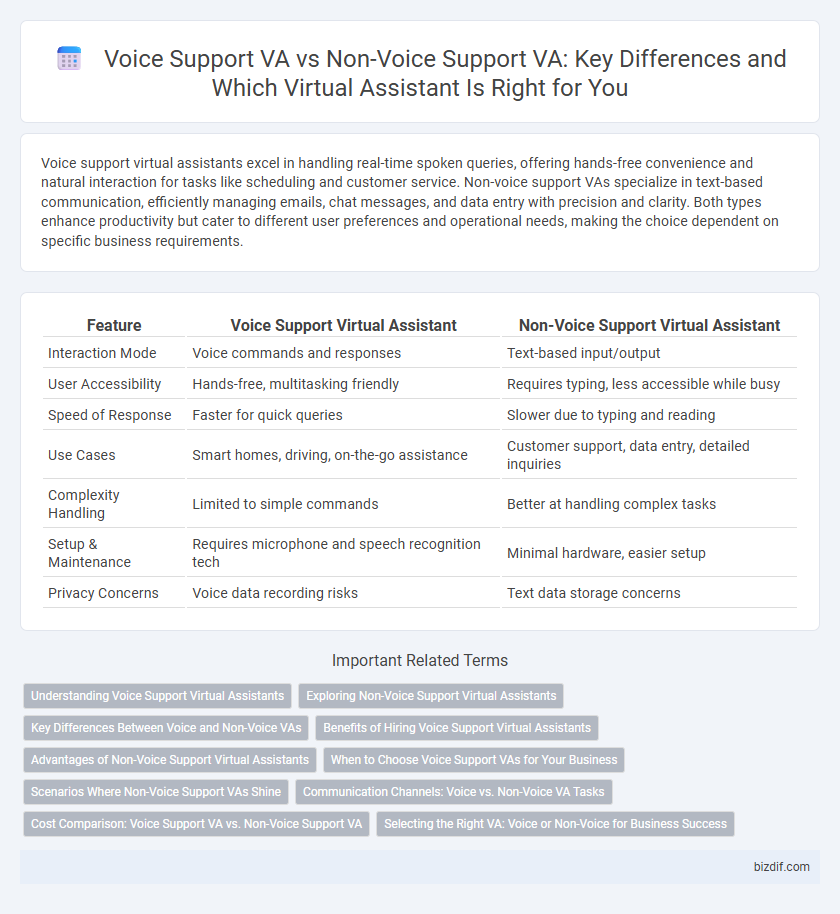Voice support virtual assistants excel in handling real-time spoken queries, offering hands-free convenience and natural interaction for tasks like scheduling and customer service. Non-voice support VAs specialize in text-based communication, efficiently managing emails, chat messages, and data entry with precision and clarity. Both types enhance productivity but cater to different user preferences and operational needs, making the choice dependent on specific business requirements.
Table of Comparison
| Feature | Voice Support Virtual Assistant | Non-Voice Support Virtual Assistant |
|---|---|---|
| Interaction Mode | Voice commands and responses | Text-based input/output |
| User Accessibility | Hands-free, multitasking friendly | Requires typing, less accessible while busy |
| Speed of Response | Faster for quick queries | Slower due to typing and reading |
| Use Cases | Smart homes, driving, on-the-go assistance | Customer support, data entry, detailed inquiries |
| Complexity Handling | Limited to simple commands | Better at handling complex tasks |
| Setup & Maintenance | Requires microphone and speech recognition tech | Minimal hardware, easier setup |
| Privacy Concerns | Voice data recording risks | Text data storage concerns |
Understanding Voice Support Virtual Assistants
Voice support virtual assistants utilize advanced speech recognition and natural language processing technologies to interpret and respond to spoken commands, enabling hands-free interaction and real-time assistance. These VAs excel in tasks such as managing calls, providing immediate information, and supporting multitasking environments, enhancing user efficiency compared to non-voice support virtual assistants that primarily rely on text-based interactions. Understanding the integration of voice-enabled AI improves customer experience by delivering faster, more intuitive communication and personalized user engagement.
Exploring Non-Voice Support Virtual Assistants
Non-voice support virtual assistants utilize text-based interactions through chatbots, email automation, and messaging platforms, enabling seamless customer engagement without relying on speech recognition technology. These assistants excel in handling detailed queries, providing documentation, and managing backend tasks with high accuracy and efficiency. Companies leveraging non-voice virtual assistants benefit from cost-effective solutions that improve customer support scalability and accessibility across multiple digital channels.
Key Differences Between Voice and Non-Voice VAs
Voice support virtual assistants (VAs) enable hands-free interaction through speech recognition and natural language processing, enhancing user convenience and accessibility. Non-voice support VAs rely on text-based communication, such as chatbots or email management, focusing on accuracy and detailed responses without voice input capabilities. Key differences include response modality, with voice VAs prioritizing speed and real-time interaction, while non-voice VAs emphasize precision and asynchronous task handling.
Benefits of Hiring Voice Support Virtual Assistants
Voice support virtual assistants enhance customer interaction through real-time communication, improving satisfaction and trust. They handle queries efficiently by utilizing natural language processing, reducing response time and operational costs. Businesses benefit from increased engagement and personalized service, driving higher conversion rates compared to non-voice support virtual assistants.
Advantages of Non-Voice Support Virtual Assistants
Non-voice support virtual assistants excel in handling complex text-based interactions, offering detailed responses and comprehensive documentation without the limitations of speech recognition errors. They provide higher accuracy in data processing and are ideal for environments requiring silent operation or where voice interaction is impractical, such as open offices and noisy settings. Text-based virtual assistants also support multitasking and asynchronous communication, enhancing productivity and user convenience.
When to Choose Voice Support VAs for Your Business
Voice support virtual assistants excel in industries with high customer interaction demands, such as healthcare, telecommunications, and e-commerce, where real-time communication enhances user experience. Businesses aiming to provide personalized, efficient, and hands-free service benefit from voice-enabled VAs that handle complex queries and reduce wait times. Opting for voice support VAs enables seamless integration with smart devices, boosting accessibility and operational efficiency in customer service workflows.
Scenarios Where Non-Voice Support VAs Shine
Non-voice support virtual assistants excel in scenarios requiring detailed text-based interactions, such as handling complex customer service queries via chat or email where clarity and record-keeping are crucial. They perform exceptionally well in environments with high noise levels or for users with speech impairments, ensuring accessibility and uninterrupted communication. Text-based VAs also facilitate multitasking by allowing users to interact discreetly without voice activation, making them ideal for professional settings.
Communication Channels: Voice vs. Non-Voice VA Tasks
Voice support virtual assistants excel in real-time verbal interactions, handling customer inquiries, appointment scheduling, and voice-based commands efficiently through phone or smart speaker platforms. Non-voice support virtual assistants specialize in text-based communication channels such as email, chatbots, and social media messaging, managing tasks like information retrieval, ticketing systems, and FAQ automation. The choice between voice and non-voice VA depends on the desired communication channel, with voice VAs enhancing conversational engagement and non-voice VAs streamlining asynchronous or written interactions.
Cost Comparison: Voice Support VA vs. Non-Voice Support VA
Voice support virtual assistants generally incur higher costs compared to non-voice support VAs due to advanced speech recognition, natural language processing, and voice synthesis technologies. Non-voice support VAs utilize text-based interactions, resulting in lower infrastructure and development expenses. Businesses aiming to reduce operating costs often prefer non-voice VAs while voice support offers enhanced user engagement and accessibility.
Selecting the Right VA: Voice or Non-Voice for Business Success
Selecting the right virtual assistant depends on business needs, with voice support VAs excelling in customer interaction through natural language processing and real-time communication, enhancing customer satisfaction and engagement. Non-voice support VAs specialize in tasks such as data entry, email management, and research, driving productivity and operational efficiency without requiring verbal interaction. Understanding the specific workflow and communication demands allows businesses to leverage either voice or non-voice VA capabilities for optimized performance and cost-effectiveness.
Voice support VA vs Non-voice support VA Infographic

 bizdif.com
bizdif.com